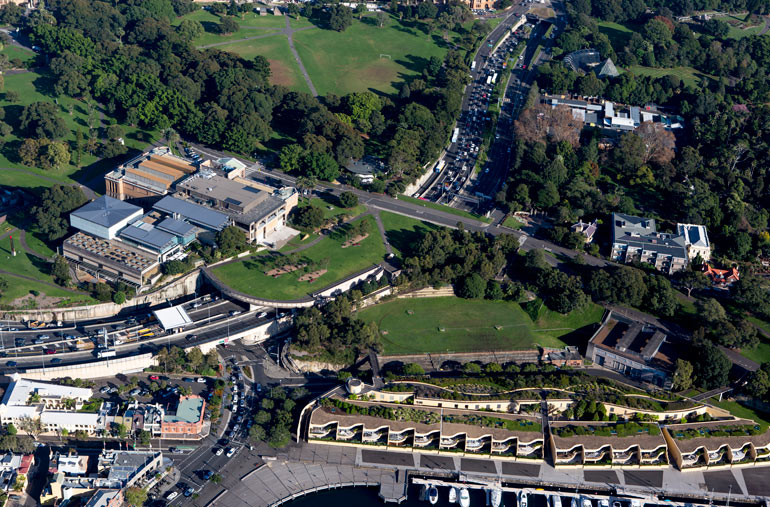A group of distinguished professionals has lodged an impeccably detailed objection to the Sydney Modern Project Development Application (DA) and Environmental Impact Statement (EIS).
Running to 40 pages, it has been prepared by urban designer and architect David Chesterman AM, horticulturist Ros Andrews, former chair of the NSW Arts Advisory Council Gillian Appleton and senior environmental lawyer Bruce Donald AM.
They analyse in turn the landscape impact of the project (Ros Andrews), the visual impact (David Chesterman), the heritage implications (Ros Andrews and Bruce Donald), the siting and cultural expansion options (Gillian Appleton), the design (David Chesterman) and access and traffic issues (Bruce Donald).
It amounts to a devastating and in my opinion unanswerable argument to call a halt and reconsider the entire project.
As the authors say in their introduction, “The EIS and its appendices are voluminous documents many years in the preparation, publicly funded at very substantial expense, in millions of dollars, for the purpose of making the case for the Art Gallery of NSW extension. The reports of the many paid advisers to AGNSW inevitably and unsurprisingly support the proposal; otherwise they would not have been included in the EIS. This means that the consent authority has a very heavy public obligation to critically review every element of the EIS and where appropriate seek further completely independent advice which is not retained by the proponent itself.”
The proposed site of the new extension covers the two green areas shown in the middle of the aerial view of the AGNSW pictured above.
The objection, lodged on 13 December, is too long to reproduce here, but the authors are prepared to share it publicly. Please feel free to email judith@cultureheist.com.au for a copy.
Submissions have now closed.
Academics come out fighting
 It’s refreshing, in these times, to see academics standing up to be counted. Just published last month is a book edited by Brad Buckley and John Conomos under the title Who runs the artworld: money, power and ethics. Both editors work at the Victorian College of the Arts, part of the University of Melbourne.
It’s refreshing, in these times, to see academics standing up to be counted. Just published last month is a book edited by Brad Buckley and John Conomos under the title Who runs the artworld: money, power and ethics. Both editors work at the Victorian College of the Arts, part of the University of Melbourne.
They and 16 contributing academics, artists, economists and curators from around the world take as the basis of the book “the belief that money, power and ethics are critical compass points of our artworld that need constant scrutiny if we are to continue to demystify the myths, and the class and political interests, that shape our art, culture and society”.
An outstanding introductory essay by the editors doesn’t pull any punches. It refers to “the recent wilful destruction of Sydney College of the Arts”, alleges that “the artworld’s politico-economic structure has transformed into a huge Ponzi scheme”, and says that with the proliferation of biennales and art fairs dependent on sponsorship “art has been transformed into a vast entertainment-industry complex where the emphasis is on audience numbers, not critical debate”.
I have to confess that I find most academic writing difficult to read these days: the succession of post-modernism, deconstructivism and post-structuralism seems to have left academe with a level of jargon that the reader has to hack through to get at the concepts. Some of the essays here are marked by such language, but all are worth persisting with for the interesting things they have to say. Some draw a provocatively long bow – Bruce Barber on curators as hedge fund managers, for instance, or Juli Carson on “libidinal economies”, a concept I still don’t get.
The chapters that appealed to me most are those written with clarity – particularly the introduction, and Adam Geczy’s essay on “The Task of the Curator”, which draws on the work of one of the 20th century’s great art theorists, Walter Benjamin, to give the discussion an historical context.
It’s a book that deserves to be widely read, and discussed in more depth than I can attempt here.
Summer arts
This is a time of year to refresh the brain and the spirit. Favourites in any area of the arts are bound to be highly subjective, but for what it’s worth here are some of my best experiences of recent weeks.
Summer exhibitions: In Brisbane, Gerhard Richter at the Gallery of Modern Art (GoMA), an enthralling show. GoMA also has a fascinating free exhibition of Japanese artist Yayoi Kusama, and some very good collection hangs. The other exhibition that thrilled me is not in an art gallery at all, but at the National Museum in Canberra: Songlines, a brilliant multimedia telling of the seminal Aboriginal story of the Seven Sisters, using video and oral storytelling along with paintings.
Summer reading: In a year of great books it’s hard to pick just a couple, but an absolute must is Peter Carey’s A Long Way From Home: memories of 1950s Australia and the Redex Trial turn into a searing exploration of Aboriginal suffering and survival. And Kamila Shamsie’s Home Fire, a modern re-telling of the classical Antigone story, with a revealing perspective on the lives of young British Muslims. It was long-listed for the Man Booker, but in my view it should have won.
Summer music: Any weekday afternoon listening to Christopher Lawrence on Classic FM – but for how long? And re-playing my Cuban CDs.
Whatever your taste, I hope the coming weeks give you the chance to recharge the batteries. And prepare for the next round of the culture wars.
The offer’s still on
Culture Heist is still available on special offer – signed copies at a reduced, postage-inclusive price. Place your order HERE for speedy delivery.





Leave A Comment